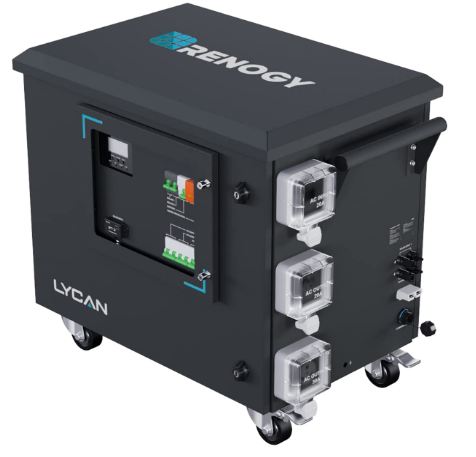Shopping for a large and rugged solar generator for home backup or off-grid power?
I recommend the Renogy Lycan 5000 Power Box, a high-capacity and high-output solar generator that can power part of your home. It can also power RVs, boats, camper vans and off-grid cabins.
Unlike most other power stations, the Lycan 5000 is designed to be wired directly to power circuits. You can even set it up as a UPS (using a transfer switch), so that it takes over when you have a blackout.
Read on for my in-depth review of the Renogy Lycan 5000.
If it’s not what you are looking for, see my reviews of the best home backup solar generators for alternatives. And if you are shopping for a smaller power station, see my roundup of the best portable solar generators.
Pros
Cons
Best Features
Rugged Design
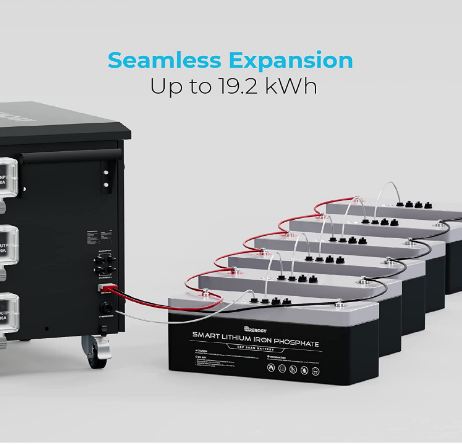
One of the first things I noticed about the Lycan 5000 Power Box, other than its massive size, is how rugged it looks. It doesn't look like any power station I’ve seen before.
The Lycan 5000 is designed for harsh outdoor conditions. It features a solid enclosure, a rain cap, and waterproof housing for the plugs.
That said, don't leave the solar generator outdoors 24/7. It’s water resistant (IP55 protection), not waterproof. Keep it somewhere sheltered to ensure longevity.
4.8kWh Expandable Capacity
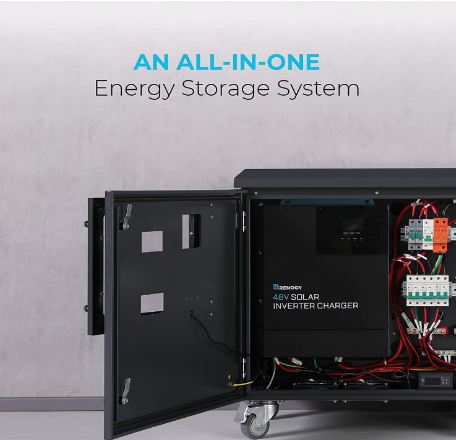
The Renogy Lycan 5000 has a capacity of 4800W or 4.8kWh. It’s not the largest solar generator I’ve reviewed (the Goal Zero yeti 6000X is bigger), but it’s still massive.
The high capacity is what makes the Lycan 5000 a great pick for home backup or off-grid power.
It’s enough capacity to keep light and essential appliances running during a prolonged power outage. It’s also plenty enough to power multiple large appliances if you are planning to go off-grid.
You can add even more capacity by connecting additional Renogy 48V 50Ah LiFePO4 smart batteries. The maximum capacity allowed is 19.2kWh, meaning you can have up to 8 batteries (including the two already included).
What Can The Renogy Lycan 5000 Power?
Here are the approximate run times to expect from the 4.8kWh Lycan 5000.
Appliance | Run time |
|---|---|
Refrigerator (135W) | 60 hours |
TV (120W) | 34 hours |
Washing machine (500W) | 8 cycles |
Coffee maker (900W) | 90 cups |
Heater (1500W) | 2.7 hours |
Power tool (1000W) | 4 hours |
LiFePO4 Batteries
The Renogy Lycan 5000 uses lithium iron phosphate batteries, instead of Li-ion batteries common in many other power stations.
LiFePO4 batteries have several advantages, the biggest one being longevity. Renogy says their batteries can last for well over 4000 cycles. In most cases, they last up to 10 years or more.
In contrast, Li-ion batteries tend to last up to 5 years.
LiFePO4 batteries are also more stable and can withstand a wider temperature range.
Their main downside is that they are heavier than Li-ion batteries because they have a lower energy density. But considering that the Lycan 5000 is not meant to be portable, the extra weight from the batteries is not a big deal.
One interesting feature of the Renogy LiFePO4 batteries is that they are self-heating. This allows them to keep charging efficiently and quickly even in cold weather.
3500W Power Output
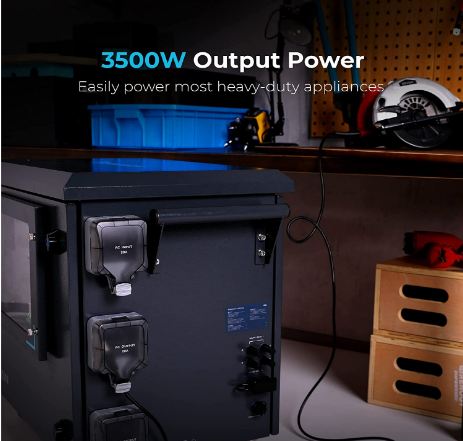
The Renogy Lycan’s power output is just as impressive as its capacity. The built-in pure sine wave inverter produces up to 3500W of continuous AC power and 7000W of surge power.
This means the Lycan 5000 can power any appliance, including heavy duty ones like power tools, portable ACs, and space heaters.
More importantly, the Lycan 5000 can power multiple appliances at the same time. This is important when you integrate the power station into your home circuits.
You can run the fridge, lights, TV, and multiple power outlets without tripping the Lycan power station.
Straightforward Home Integration
Most power stations have numerous outlets, including AC, DC and USB. The Lycan 5000 has just two outlets: a 20A and a 30A outlet.
You can plug appliances directly into these ports. If you want to power more than two appliances at the same time, you can use an appropriate size power strip.
But if you plan to use the Lycan 5000 for home backup or off-grid power, it’s more convenient to wire it directly to your home.
There are two ways to do this.
If you are off-grid, you’ll need a breaker panel plus other required accessories like circuit breakers and a NEMA TT-30P to bare wire adapter cable. Check the manual and consult an electrician to ensure proper and safe setup.
You can then select which circuits you want to power with the Lycan 5000, keeping in mind that its max output is 3500W.
If you are using the Lycan 5000 for home backup, you’ll need a manual or automatic transfer switch. Connect to the circuits you want to power during a blackout, again keeping in mind the 3500W load limit.
Fast Dual Solar & AC Charging
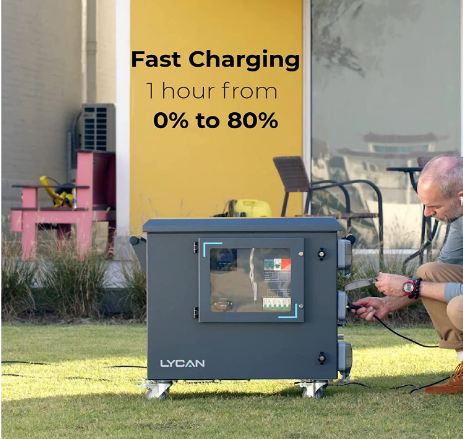
Normally, such a large capacity system would take hours or probably the entire day to charge. Thankfully, that’s not the case with the Lycan 5000.
There are two ways to recharge the batteries, both of them fast.
You can plug it into a standard wall outlet. It’ll charge in just 3 hours, which is really impressive for a 4.8kWh power station.
The Lycan 5000 charges even faster via solar. That’s because it accepts up to 4400W in solar power via the built-in MPPT charge controller. That’s more than any power station I’ve seen.
If you set up a 4400W array, it can take as little as 2.5 hours to recharge the Lycan 5000.
There’s a third even faster charging option. The Lycan 5000 has dual AC + solar charging with a combined input of 6500W.
On a sunny day, you can use dual charging to recharge the Lycan 5000 in just 1.3 hours.
Modular Design With Accessible Components
I’ve already mentioned how rugged the Lycan 5000 looks compared to other power stations. Another way it stands out is its modular design.
With regular power stations like Jackery, Goal Zero and Bluetti, everything is neatly packed away behind the exterior cover. You cannot access any of it.
With the Lycan 5000, Renogy has just taken the regular solar components they sell separately (e.g. batteries, inverter charger, etc.) and wired it together inside the box.
The box has doors on both sides, allowing you easy access to all these components including circuit breakers.
The biggest advantage of this is that when one part breaks, you don't need to toss out the entire power station. Just replace that particular part.
This makes repairing and maintaining the Lycan 5000 much easier than other power stations.
Remote Monitoring
The Renogy Lycan 5000 has a viewing window through which you can see a display with all the charging and discharging info you need to know.
But there’s an even easier way to monitor the power station. The Lycan 5000 comes with a bluetooth module, which lets you link it to your smartphone.
You can then use the DC Home app to check the status of the power station.
You can also link the Lycan 5000 to the Renogy ONE M1 energy monitor. The M1 monitor can also link to the DC Home app. And since the monitor has WiFi connectivity, it can send information regarding your power station to the app wherever you are.
Issues & Limitations
Heavy
The Renogy Lycan 5000 weighs 264.6lbs. It’s anything but portable. The most you can do is move it around your home, and even that is not easy.
Fortunately, it comes with wheels so you don't have to lift it. Two of the casters have brakes to keep the power station in place once you set it up.
Pricey
The Renogy Lycan 5000 is also not the best choice if you are shopping for a budget power station. It is pricey, but understandably so.
No Vehicle Charging Option
There’s no way to charge the Lycan 5000 from your vehicle, whether directly from the battery or via the 12V/24V cigarette lighter port.
This is a limitation if you plan to use the Lycan 5000 in your van, motorhome or RV. In that case, your only option for charging the power station on the go is solar panels.
Best Alternatives To The Renogy Lycan 5000
Hybrid Power Solutions Batt Pack Energy - Vehicle Charging Option
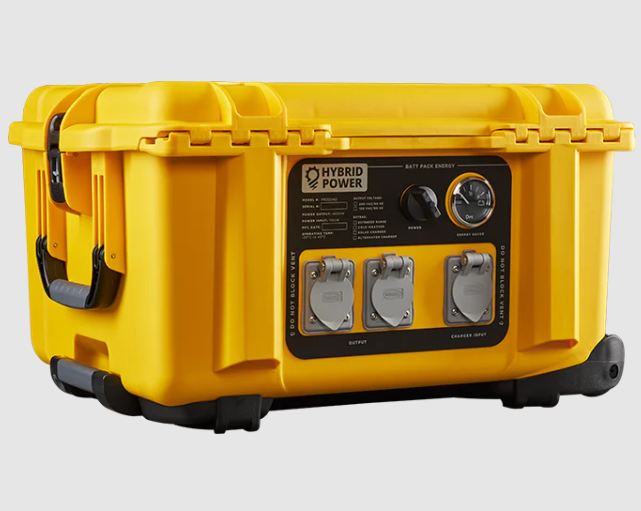
The most similar power station to the Renogy Lycan 5000 is the Hybrid Power Solutions Batt Pack Energy power station.
Hybrid Power Solutions is a solar company based in Canada, but they offer free shipping to Canada and the US.
The Batt Pack Energy power station has the same rugged and weatherproof outdoor-friendly design as the Lycan 5000.
It’s also designed for home integration. It only has a couple of output ports.
Hybrid Power Solutions sells various versions of the Batt Pack Energy power station. The base model has 2.5kWh capacity (LiFePO4 batteries) and 4000W output. There’s also an extended range version with 3.6kWh capacity and 4000W output.
The main advantage the Batt Pack Energy power station has over the Lycan 5000 is the ability to charge it from your vehicle’s battery. This is really handy if you plan to set it up in a camper van, motor home, RV or even boat.
You’ll need to add the alternator charging kit to your order when buying the power station.
With this kit, you can wire the Batt Pack Energy power station to your vehicle’s alternator, which provides faster charging compared to plugging it into the 12V/24V cigarette lighter outlet.
Bluetti EP500 Pro - Multiple Outlets
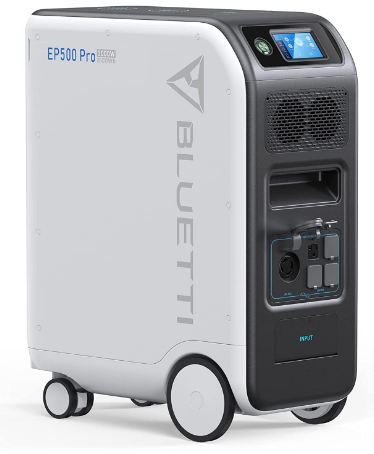
If you don't want or need to integrate the power station to your home circuit, the best alternative to the Lycan 5000 is the Bluetti EP500 Pro.
The EP500 Pro has a capacity of 5100Wh and an output of 3000W. Similar to the Lycan 5000, the EP500Pro uses long lasting LiFePO4 batteries.
The biggest difference between the two is that you can plug multiple appliances and devices directly into the Bluetti EP500 Pro.
It has 17 outlets including five 3000W (6000W surge) AC outlets, two 100W USB-C ports, four USB-A ports, a 12V/10A car port, a 12V/30A RV port, two 12V/10A 5521 ports and two 15W wireless charging pads.
Having these outlets makes the Bluetti EP500 Pro more versatile. You can set it up in different places at home and even take it with you when truck camping, overlanding or RV boondocking.
The EP500 Pro is almost 100 pounds lighter than the Lycan 5000, so it’s a bit more portable.
EcoFlow Delta Pro - Cheaper & Lighter
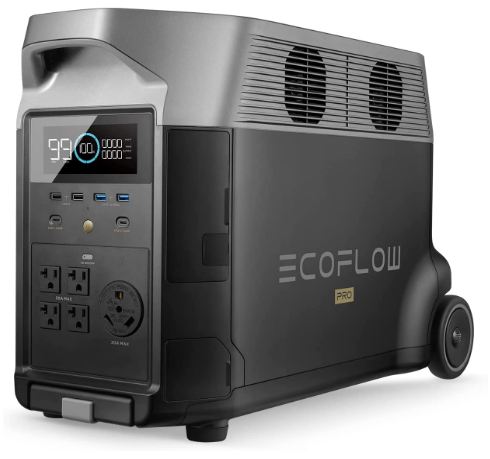
The EcoFlow Delta Pro is another high-capacity, high-output solar generator, but it’s lighter and cheaper than the Lycan 5000 or the two alternatives I’ve discussed above.
The Delta Pro has a capacity of 3.6kWh (LiFePO4 batteries) and an output of 3600W. And if you need more capacity, it’s expandable to 25kWh.
Similar to the Bluetti EP500, the Delta Pro offers numerous outlets including five AC ports, four USB-A ports, two 100W USB-C ports, a 12V/10A car port, two 12V DC5521 ports and a 30A Anderson port.
The EcoFlow Delta Pro weighs 99 lbs, making it the most portable option out of all the ones we’ve discussed.
Care and Maintenance
The LiFePO4 batteries in the Renogy Lycan 5000 don't need any maintenance. The best way to take care of them is keeping the power station in an optimal temperature range.
Avoid using or storing it in extremely cold or hot environments. Extreme temps accelerate battery deterioration.
Renogy also recommends cleaning the power station, especially the fans, connectors and enclosure often. Check the manual for specific cleaning instructions.
When you store the Lycan 5000 for a long time, first charge it to between 30% and 50%, then recharge it every three months.
Warranty
Renogy offers a 3-year material and workmanship warranty on the Lycan 5000 Power Box.
Specifications | |
|---|---|
Weight: | 264.6lbs |
Size: | 32.9 x 20.0 x 28.5 in |
Capacity: | 4800Wh, expandable to 19200Wh |
AC output: | 3500W continuous, 7000W surge pure sine wave inverter |
Outlets: | 2xAC |
Max solar input: | 4400W |
Charging time: | 3hrs with AC adapter, 2.5 hours with 4400W solar, 1.3 hours with solar + AC |
Battery chemistry: | Lithium iron phosphate |
Battery lifespan: | 3000+ cycles to 80% |
Operating temperature: | 14°F - 122°F |
Where To Buy
The Renogy Lycan 5000 Power Box is available on Renogy’s official website. You can also order it on Amazon.

